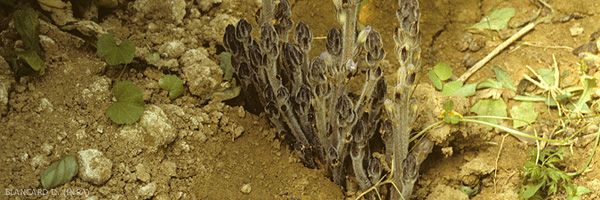
Orobanche spp. (broomrape)
The broomrape ( broomrapes ) are parasitic plants, devoid of roots and chlorophyll, including nutrition is totally dependent on their hosts. More than 150 species have been listed. They attack many plants, whether cultivated or not, in particular Solanaceae, Fabaceae and Cucurbitaceae, on which they can cause significant damage. The most harmful species are mainly located in the Mediterranean basin, southwestern Asia and a few other regions with a climate close to the Mediterranean type (western Australia, California ).
In France, the ( Orobanche ramosa L. syn. branched broomrape Phelipaea ramosa CA Meyer), a species with the broadest host spectrum, is on the rise, in particular on hemp, rapeseed and another olanaceae, tobacco. To our knowledge, it does not appear to present any major problems to field tomato crops at this time. Note that several other species Orobanche have been described on tomato; O. aegyptiaca Pers., O. cernua Loefl
The appearance of colored tufts of white, yellow or purple at the foot of the plants characterizes the parasitism of the broomrape (Figures 1 and 2). These tufts correspond to the flower stems which can be one to several tens of centimeters high. These scapes bear pale blue to purplish blue flowers in the case of O. ramosa , which will produce capsules containing 300–500 seeds each (seeds 0.2–0.4 mm long).
In fact, the parasitism of orobanche mainly concerns the roots of tomatoes on which they set up suckers, then tentacular anchoring roots, which allow them to absorb the mineral elements essential for their growth. The plants are weakened and therefore smaller and stunted. Ultimately, fruit yields are reduced. In addition, these plants are unable to regulate their stomatal transpiration in the dry period, so they maintain their host in chronic water deficit.
The broomrapes are preserved in the rather superficial layer of the ground by the intermediary of their tiny seeds, which perennialize there during several years; 10 and more. They can also be maintained and multiply in the soil through numerous cultivated hosts (example of vegetables susceptible to O. ramosa : eggplant, lettuce, pepper, Cucurbitaceae, broad bean, pea, carrot, celery, fennel ) and certain weeds ( Capsella bursa-pasteuris , Solanum spp., Amaranthus spp ). In the presence of a sufficiently moist soil and stimulated by root exudates, the seeds germinate and attach themselves to the roots of their host. Subsequently, the broomrape penetrates into these and set up a sucker in connection with the xylem of its host, allowing them to ensure their carbonaceous, mineral and water supply to the detriment of the plants. It is at this time that the first underground growth of the stem begins. It does not take long to emerge and form the floral stalk, which blooms thereafter. Ultimately, several tens of thousands of seeds will be produced per plant Orobanche . These can be disseminated by irrigation water or following floods, by wind, animals, tillage tools, polluted seed lots
The fight against these highly polyphagous parasitic plants is often very delicate because of their enormous potential for conservation and dissemination. We still recommend that you implement the following measures:
- pull up or destroy by all means the parasitic plants before they bloom;
- in the presence of an early outbreak, treat the broomrapes and their hosts with a herbicide such as glyphosate to prevent the plants from producing seeds which will return to the soil;
- optimize the fight against certain weeds (brassicaceae ) which can replace tomatoes and perpetuate these parasitic plants in the absence of sensitive crops;
- in some countries, disinfection of the soil with a fumigant is envisaged (methyl bromide). The Solarize would destroy part of the seed stock present in the first few centimeters of the soil;
- Deep burying of the seeds is sometimes recommended because it keeps them away from future tomato roots which will not be parasitized until late. This practice is however controversial because it contributes to their conservation;
- the increase in nitrogenous manure would reduce infestations by reducing their power of germination and fixation on their hosts. Ammoniums would be more inhibitory than nitrates;
- avoid contaminating new plots with soiled agricultural equipment. To do this, we suggest that you always work the infested plots last and wash the equipment well afterwards.
By way of example, let us point out that resistance to O. aegyptiaca , monogenic, dominant and controlled by the “ gene Ora ” , has been demonstrated and worked on in tomatoes in Egypt.





